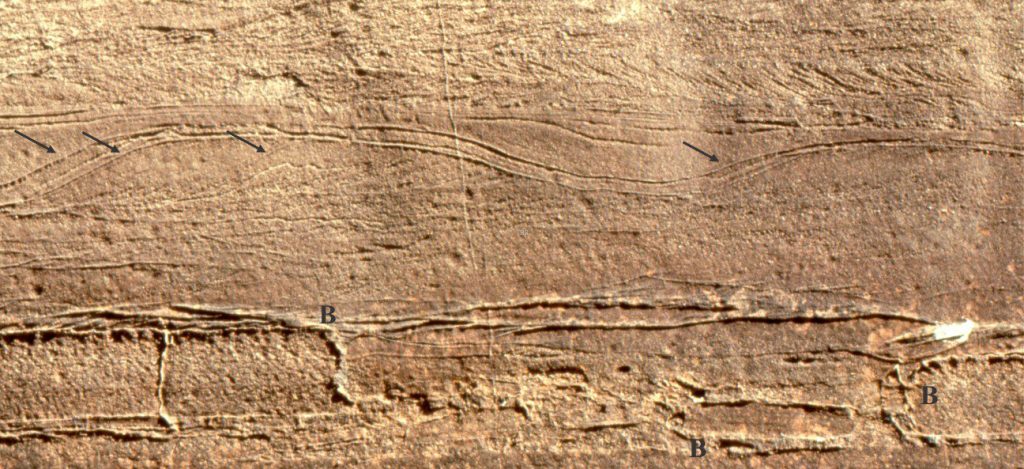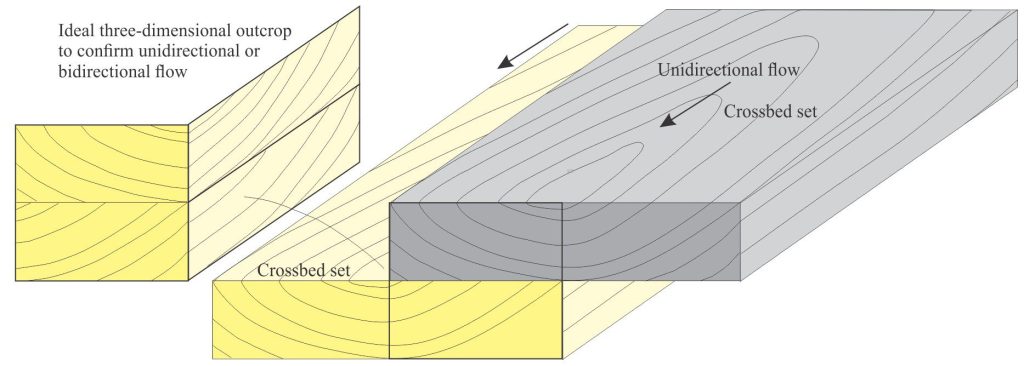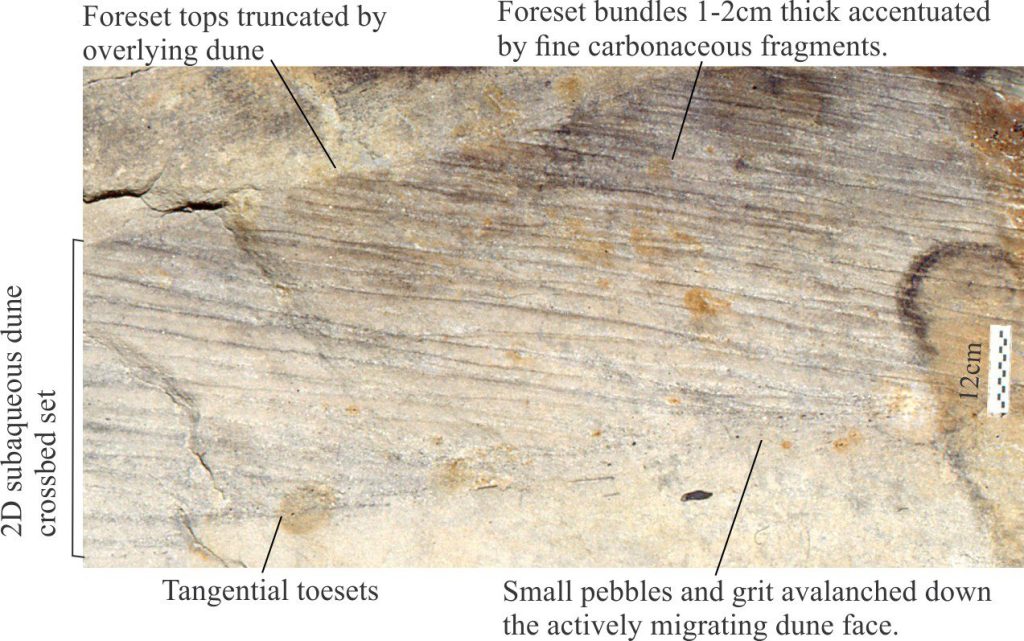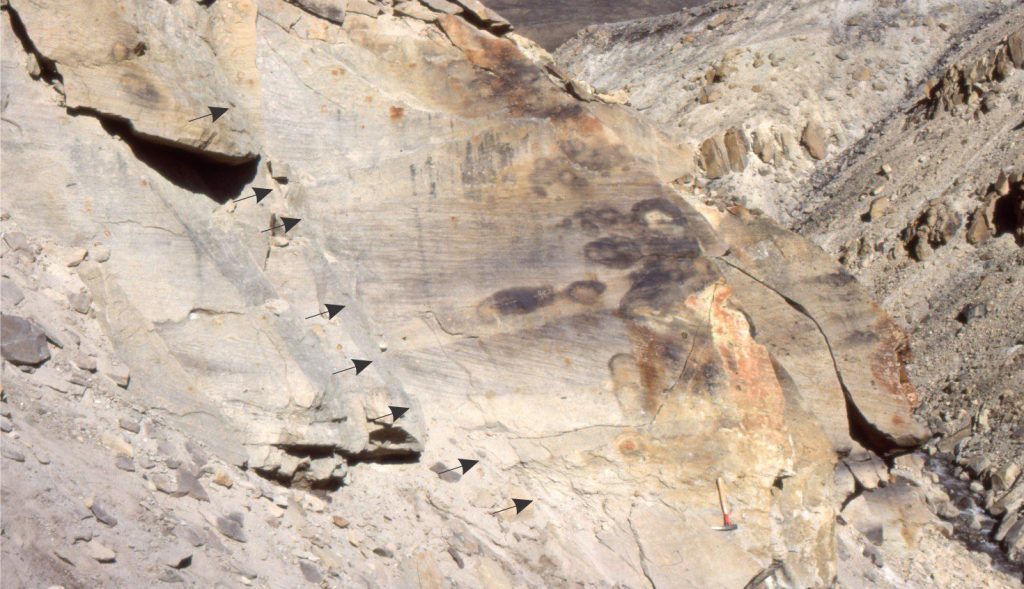
Introducing subaqueous dunes formed or modified by tidal currents
Use this link to read the introduction to the lithofacies series.
A very small subset of all the ripple types that we recognize can, with some confidence be attributed to shallow marine, and more specifically to intertidal environments. These are lenticular and flaser bedding, and interference ripples. The subset for larger, tidally influenced subaqueous dunes is also small and includes:
- Reactivation surfaces,
- Herringbone crossbedding, and
- Tidal bundles.
Reactivation surfaces on subaqueous dunes
External structure
Reactivation surfaces can form on subaqueous 2D and 3D dune bedforms at almost any scale. They are most commonly reported in sand lithologies, primarily because truncation of foreset laminae is more difficult to identify coarser-grained lithologies such as gravels and conglomerates. Typically, the bedform crest is eroded such that the transition from stoss face to lee face occurs over a more arcuate, rounded surface. Sediment eroded from the crest may be deposited on the stoss face or trough between adjacent dunes.

Internal structure
Erosion at the bedform crest results in truncation of crossbed foresets. The actual surface of erosion can be traced down the lee face and in many cases will be overlain by another group of foresets. The alternating processes of normal foreset deposition during dune migration followed by crest truncation may be repeated several times in a single dune.

Formation – hydrodynamic conditions
Modification of 2D and 3D bedform crests can occur pretty well anywhere these bedforms develop – in marine and non-marine environments where current and sediment transport directions change. In sandy fluvial systems this can occur during migration of, or the transition from active to inactive channel bars, or changing directions of flow during floods. However, in most of these environments, the reactivation surfaces generally occur as isolated structures. In comparison, the periodicity of tidal currents can potentially reactivate each dune multiple times – this will be reflected in the crossbed foreset stratigraphy.
Common occurrences
Reactivation surfaces on subaqueous dunes are commonly attributed to tidal current reversals in shallow subtidal and intertidal settings, particularly in dunes that accumulate on broad tidal flats in lagoons, estuaries and coastal embayments. Although reactivation-like surfaces can occur in non-marine deposits, the attribution to tidal current reversal can be stated with some confidence if periodic reactivation is observed in single and multiple bedforms.
Under these conditions, reactivation surfaces may be associated with lenticular and flaser bedding, interference ripples, wave ripples, desiccation structures including those in microbial laminates, vadose carbonate cements, beachrock, and paralic benthic faunas and trace fossil assemblages.
Herringbone crossbeds
External and internal structure
Herringbone crossbedding is generated when one crossbed set that indicates bedform migration in one direction, overlies a similar sized crossbed set that indicates migration in the opposite direction. The opposing foreset dip directions confer a herringbone-like geometry. Contact between the two bedforms is planar. This bedform arrangement can only be seen in outcrop cross-sections. They can form in dune bedforms of almost any size but are most commonly observed in decimetre to metre-sized structures.

The bedding manifestation of herringbone crossbeds is more problematic. Theoretically, it involves one bedform migrating over another, the directions of migration being about 180o apart. However, the upper bedform will probably bury the lee face of the lower bedform. In general, confident identification of this structure requires good outcrop profile views of cross stratification, rather than bedding plane views.
Herringbone crossbeds can form in 2D and 3D subaqueous dunes. To be confident that the two crossbed sets actually represent opposing bedform migration directions, the outcrop must allow observation of both sets in three dimensions. The reason for this is that overlapping dunes formed under unidirectional current flows may show opposing foreset dip directions depending on the orientation of the outcrop with respect to that of the bedform. This problem is illustrated in the following diagram.

Formation – hydrodynamic conditions
True herringbone crossbedding is usually attributed to tidal current reversals, where current strength is sufficient to form 2D and 3D subaqueous dunes (lower flow regime; Froude subcritical velocities) – one dune set forms on the flood tide, the overlying set on the ebb tide.
Common environments
Herringbone crossbedding is most common in shallow subtidal and intertidal settings where the potential for deposition is approximately the same for flood and ebb tides. It may be associated with any of the lithofacies that also occur with reactivation surfaces (noted above).
Tidal bundles
Internal structure
Like herringbone crossbedding, tidal bundles require good cross-sectional exposure of foresets for confident identification. Tidal bundles are most easily observed in sandy, decimetre to metre-sized subaqueous dunes. The primary indication of bundling is the repetition of sandstone foresets, each coupled to a veneer of siltstone or mudstone. The fine-grained laminae may be continuous or discontinuous across the foresets. The muddy layers may also be carbonaceous or micaceous. Individual foresets are generally millimetres to a few centimetres thick.


Formation – hydrodynamic conditions
The most important criterion here is evidence for bundling or repetition of sandstone and fine-grained foreset couplets, a transition that implies periodic changes in current velocity and flow competence. The fine-grained layers imply deposition in weak currents, possibly involving suspension fallout. An interpretation involving tidal currents is a logical outcome, so long as a degree of periodicity can be demonstrated within single crossbed sets and among multiple sets. The tidal regime in this case involves relatively strong currents in one direction and weaker currents in the opposite direction.
Common environments
The most common occurrences of foreset bundling in the rock record are with inner and mid-shelf dune bedforms – the dunes may be part of larger, shelf sandwave complexes, as well as sandy tidal flats. There has been considerable research into the relationship between tidal couplet periodicity and spring or neap tides. The primary reason for this level of interest in skinny crossbed foresets is that recognition of spring or neap periodicity has implications for astronomical, Earth-lunar tides and the duration of ancient lunar months ( e.g., Mazumder and Arima 2005). Possible lunar tidal forcing has been identified in rocks as old as 3.2 billions years (Heubeck et al., 2022).
Other posts in this series
Sedimentary lithofacies – An introduction
Ripple lithofacies: Ubiquitous bedforms
Ripple lithofacies influenced by tides
Tabular and trough crossbed lithofacies
Laminated sandstone lithofacies
Low-angle crossbedded sandstone
Hummocky and swaley cross-stratification
Lithofacies beyond supercritical antidunes
Introducing coarse-grained lithofacies
Powered by how to take agency of pan card

















